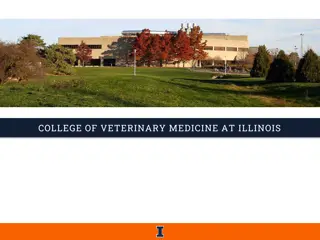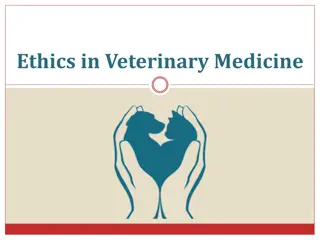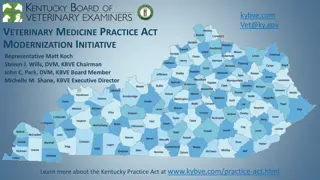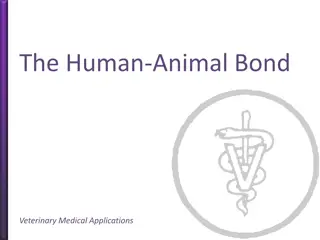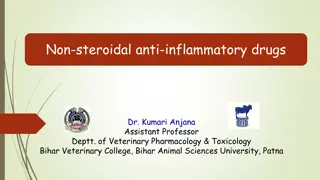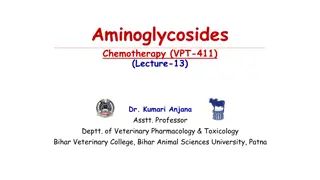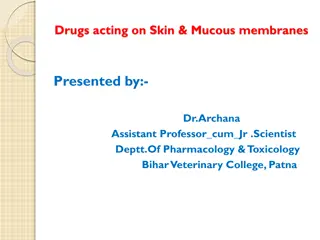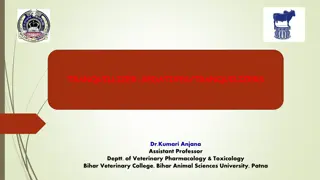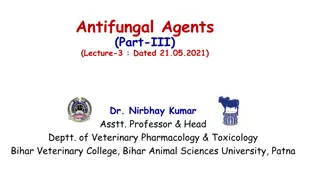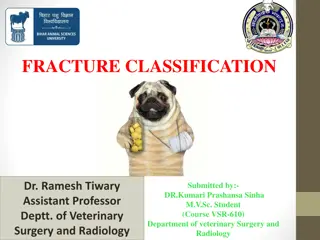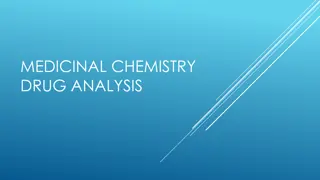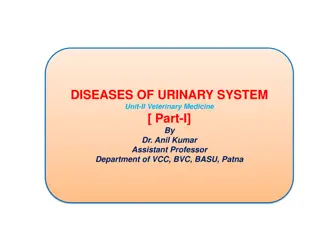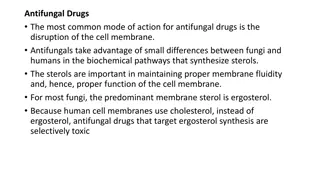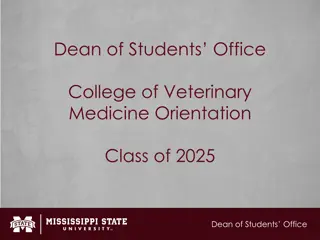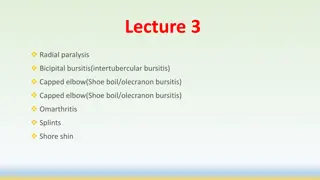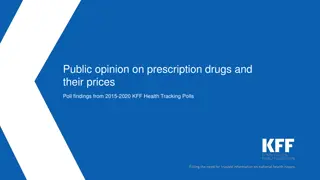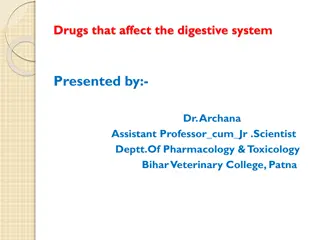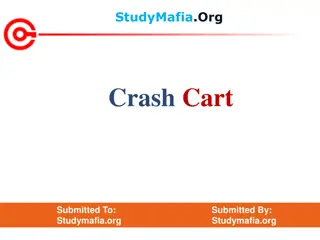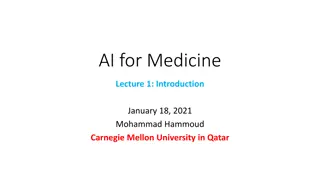Understanding Antitrematodal Drugs and Their Applications in Veterinary Medicine
Fascioliosis caused by F. hepatica is a common concern globally, impacting livestock health and economy. Antitrematodal drugs play a crucial role in combating parasitic infections like fascioliosis. One such drug, Carbon tetrachloride (CCl4), has been effective in treating F. hepatica due to its action on cholesterol biosynthesis and interference with the metabolism of flukes. This drug is cost-effective, well-tolerated, and mainly utilized in fascioliasis treatment. Understanding the mode of action of antitrematodal drugs is vital in ensuring effective treatment against parasitic infections in animals.
Download Presentation

Please find below an Image/Link to download the presentation.
The content on the website is provided AS IS for your information and personal use only. It may not be sold, licensed, or shared on other websites without obtaining consent from the author. Download presentation by click this link. If you encounter any issues during the download, it is possible that the publisher has removed the file from their server.
E N D
Presentation Transcript
ANTHELMINTICS Antitrematodal drugs Chemotherapy (VPT-411) (Lecture-23) Dr. Kumari Anjana Asstt. Professor Deptt. of Veterinary Pharmacology & Toxicology Bihar Veterinary College, Bihar Animal Sciences University, Patna
Content of the chapter Antitrematodal drugs Introduction, classification spectrum of activity MOA Applications Side effects
Introduction Fascioliosis caused by F. hepatica is most common worldwide and has greatest economic importance. Fig: F. hepatica Source : Google image The rumen fluke- Paramphistomum in cattle and lung fluke - Paragonimus in dogs and cats are important. Fig: Fascioliosis (cow liver) Source : Google image
Classification Drugs Against Adult Flukes Both Mature and Immature Flukes Antitrematodal drugs Drugs Against Immature Flukes
Drugs Against Adult Flukes Carbon tetrachloride (CCl4): First effective drug for treatment of F. hepatica (1920). It is cheap antitrematodal drug and effective against adult F. hepatica well tolerated in sheep and economic. Thus it is mainly used for treatment of fascioliasis. Earlier it was used for ascariasis in dog, cat and poultry, Ancylostoma of dog and cats and stomach worms of cattle, but has now replaced by more effective drug.
Mode of Action: The anthelmintic action of CCl4 is thought to be indirect through its metabolites or by inducing formation of toxic methylsterol in the host liver due to interference with the cholesterol biosynthesis. in liver Carbon tetrachloride Methylsterol In the host - methylsterol is an intermediate metabolite in biosynthesis of cholesterol.
CCl4blocks the cholesterol biosynthesis at a point that results in the formation and accumulation of toxic methylsterols in the liver, bile and urine of treated animals. This methylsterol is highly toxic to the flukes and produces lethal effects by interfering with the secretory and enzymatic activity of the gut epithelium of the parasite.
It also uncouples oxidative phosphorylation in the mitochondria and interferes with anaerobic generation of ATP by the flukes. This results in death of the flukes. After oral administration CCI4 is absorbed in the intestine (increased by fats and oil), metabolized in liver and the active metabolite is excreted in bile and urine. So the adult flukes (12 weeks or older) living in the bile ducts are killed but the immature flukes living in the liver parenchyma are not affected.
Disadvantages: Lacks activity against immature flukes. Highly toxic to mammalian liver (hepatotoxic) So cannot be used in cattle, horse, pig and cat. High dose causes giddiness, unconsciousness and cardiovascular collapse. Toxicity is more in debilitated animals, animals with diseased liver, high fat diet, in cold weather (due to decrease excretion through expired air).
Hexachloroethane: Less toxic then CCl4. Highly effective against all species of adult Fasciola in cattle and also against Haemonchus and Trichostrongylus. But is not effective against immature flukes and intestinal nematodes of ruminants.
Hexachloroparaxylene: It is chlorinated derivative of benzene. It is a highly effective fasciolicide against F. hepatica in sheep. Combined with phenothiazine for the treatment of liver flukes and GI nematodes in ruminants. Superior to CCI4 and hexachloroethane because: i. High tolerance in sheep and ii. Does not cause blood dyscrasia.
Tetrachlorodifluoroethane: It is a halogenated hydrocarbon, effective against only adult F. hepatica (not against immature forms) infection and well tolerated in sheep. The drug is not used in cattle since it is less effective against liver flukes and also produces severe toxic reactions.
Hexachlorophene (Distodin): It is used in the treatment of mature liver fluke infections in human and ruminants and cestode infection in canines. The drug is 100% effective against adult F.hapatica and F. gigantic in sheep and cattle.
This is because the drug remains in free form in bile and the host metabolite (glucuronide) excreted in bile has high activity especially against adult flukes, as they remain in the bile ducts. However, the immature flukes (<8weeks old) bathed in the blood of liver parenchyma, are not affected because the free drug is less available to this immature flukes due to its plasma protein binding.
Bithinol sulfoxide: Besides anticestodal properties, bithinol and its sulfoxide has excellent efficacy against rumen and liver flukes (Fasciola hepatica, F, gigantic, Fascioloides magna and Paraphistomum spp)of domesticated and wild ruminants also much more effective against adult than immature flukes. Bithionol sulfoxide @30mg/kg + Hexachlorophene @ 50 mg/kg: 100% effective against mature F.hepatica in cattle and sheep.
Bromosalans: This is the mixture of dibromosalans and tribromosalans. The drug has equal efficacy for adult flukes as other fasciolicidal drugs and has been used for the treatment of F.hepatica infection. Extra advantage of bromosalans is that it is 100% effective against juvenile flukes (6-10 weeks age).
Oxyclozanide: It is a salicylanilide compound having fasciolicidal activity. In Vivo, it is only active against adult liver flukes that live in the bile duct. Like hexachlorophene and nitroxinyl, It is also not effective against immature flukes because of protein biding in blood. Drug has zero withdrawal for milk and short withdrawal period for slaughter.
Given in therapeutic doses to debilitated and pregnant animals without any side effect. It is highly effective against adult and immature F.hepatica in sheep but the doses needed for immature flukes are less safe. Analogue of hexachlorophene effective against adult F.hepatica in sheep, cattle and pigs at safe doses also effective against immature flukes at higher doses but is less safe. The drug is mostly used in sheep.
Nitroxynil: Injectable fasciolicide. Active against adult liver flukes (F.hepatica and F.gigantica) in cattle and sheep, with some activity against fly larvae (Oesterous oviss) and blood sucking nematodes. It is also used to treat gapeworms (Syngamus) in poultry slaughter is 31 days.
Rafoxanide: Effective against adult and young (6-10 weeks old) liver flukes in sheep. It is also indicated in the treatment of blood sucking nematode infections (haemonchosis, bunostomiasis) and for tissue invading fly maggots (sheep nasal bot).
Bromophenophos: It is an organophosphoric acid ester, used for the treatment of mature F.hepatica infections in cattle. It has also good efficacy against immature liver flukes. Clorsulon: Oral fasciolicide adult and young immature liver flukes (6-8 weeks old). MOA: Embden-Myerhop glycolytic pathway in the parasite and deprives the fluke of essential metabolic energy.
Closantel: Closantel has a broad range of anthelmintic activity, affecting both endoparasites as well as ectoparasites (endectodcide) of animals. The drug is effective against adult and juvenile (6-10 weeks old) liver flukes, blood sucking nematodes, parasitic larvae of files and to some extent against tapeworms, mange, mites and ticks. It is not carcinogenic, teratogenic or embryotoxic. Benzimidazoles: Highly effective against adult F.hepatica and Fascioloides magna in sheep and cattle and used therapeutically.
Drugs Against Immature Flukes Diamfenetide: Exceptionally high activity against the immature stages of liver flukes especially in sheep and comparatively less activity against adult flukes. It is inactive in cattle. De-acylation in the liver of the host by hepatic enzymes active amine metabolite is formed in the hepatic parenchyma which is responsible for its activity. Rapid killing of immature flukes that are also located in the liver parenchyma until they are seven weeks of age.
The flukicidal effect is due to affecting permeability of cells and vacuolation of tegument rapidly inactivated by liver. The drug is less effective against adult flukes as only a small amount of the active drug reaches to the mature flukes, located in the bile ducts. 7-day withdrawal period for meat.
Both Mature and Immature Flukes Triclabendazole: It is highly potent against liver fluke F. hepatica from day old to adult. But it has no antinematodal activity. Mode of Action: Not known. Different from that of other benzimidazoles. Pharmacokinetics: Triclabendazole Sulphoxide Sulphone Major metabolite excreted in bile
Dosage: Oral: Sheep and Goats @ 10 mg/kg; Cattle: @ 12 mg/kg. Toxicity & Safety: The drug is well tolerated orally in sheep and cattle. It is neither embryotoxic in rats. teratogenic nor Precaution: The drug should not be given to animals producing milk for human consumption. 28day withdrawal period for meat. Source : Google image
Drugs for Paramphistomiasis Paramphistomiasis is very common in India. Symptoms : Anorexia, increased water intake and water foetid diarrhoea. Drugs used against liver flukes and cestodes in ruminants give good results in paramphistomiasis. The following drugs are used effectively in the treatment of paramphistomiasis in sheep and cattle. Niclosamide: @ 90 mg/kg, oral Resorantel: @ 65 mg/kg, oral Bithionol: @ 70 mg/kg, 2 doses orally at 48 hours interval. Bithionol sulfoxide: @ 60 mg/kg, single dose.
Drugs for Paragonimiasis Paragonimiasis is caused due to lung infection by paragonimus in dog and cats. The drugs available for treatment of paragonimiasis in dog and cat: Praziquantel Albendazole Fenbendazole Bithionol: Effective at high doses, but efficacy is unpredictabl(produces undesirable side effects).
Control Therapeutic control is the practicable method of minimizing trematodal infestation in livestock. Antitrematodal treatment is recommended at the start of monsoon and early summer season. This reduces the passage of eggs, contamination of grazing areas and thus the chances of infection of grazing livestock. The drugs that are ineffective against the immature or young flukes need to be repeated on a later date, so that the young ones are matured and eliminated subsequently.
The livestock should not be allowed to graze near or on marshy areas, where the intermediate host of flukes habitats (snails). Use of molluscicides helps in elimination of the snails. The molluscicides are -- Copper pentachlorophenate @ 11 kg/ha), Copper sulphate (5% @ 10 kg/ha) and Pentachlorophenol.
Summary Diamfenetide : Exceptionally high activity against the immature stages of liver flukes especially in sheep and comparatively less activity against adult flukes. Triclabendazole is highly potent against liver fluke F. hepatica from day old to adult. Hexachlorophene (Distodin): The drug is 100% effective against adult F.hapatica and F. gigantic in sheep and cattle. Therapeutic control is the practicable method of minimizing trematodal infestation in livestock.
References B.K.Roy., Veterinary Pharmacology and Toxicology 2011, Kalyani Publication, pp -465-468. H.S. Sandhu and S. Rampal., Essential of Veterinary Pharmacology and Therapeutics , pp- 1268-75. Prasad V. Vani. and Koley K.M., Synopsis of Veterinary Pharmacology and Toxicology 2006, Vahini Publications, pp-253-257.








